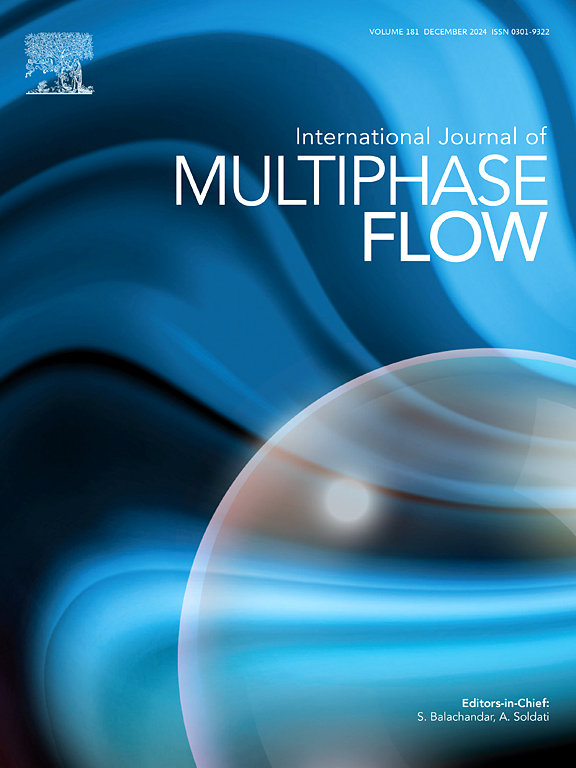An experimental and numerical investigation to study slug characteristics in miniature geometries
IF 3.8
2区 工程技术
Q1 MECHANICS
International Journal of Multiphase Flow
Pub Date : 2025-06-28
DOI:10.1016/j.ijmultiphaseflow.2025.105342
引用次数: 0
Abstract
This research presents the prediction of slug length in liquid-liquid two-phase flow using a straight mini capillary of an inner diameter of 2 mm. The study focused on understanding the effects of flow dynamics and thermophysical properties on slug characteristics. Three different combinations of glycerol in distilled water (v/v%) are used to vary the thermophysical properties of the continuous phase. While toluene is used as the dispersed phase. Droplet flow and slug flow are observed as the main flow patterns. The slug length is found to have a proportional relationship with the Reynolds number of the disperse phase while inversed relationship with the Reynolds number of the continuous phase. At a constant Reynolds number of the disperse phase, the specific interfacial area steadily declined with the Reynolds number of the continuous phase. A criterion is proposed for the transition of flow patterns in the form of dimensionless numbers. Further, numerical simulations are performed to understand flow physics at different thermophysical properties using the open software OpenFoam. The inner circulation inside the slug is observed to increase with a decrease in the glycerol content in the continuous phase. Based on experimental data, an artificial neural network model is developed to predict slug length. The results showed that the model successfully establishes the relation between the thermophysical properties of fluids, wall wettability of channel, and slug length. Further, the model is validated with the previously published data and present simulation, showing high accuracy.

微型几何形状中段塞特性的实验与数值研究
本文采用内径为2mm的直线型微型毛细管对液-液两相流中段塞长度进行了预测。研究的重点是了解流动动力学和热物理性质对段塞流特性的影响。在蒸馏水中使用三种不同的甘油组合(v/v%)来改变连续相的热物理性质。而甲苯则用作分散相。液滴流动和段塞流动是主要的流动形式。段塞长度与分散相的雷诺数成正比关系,与连续相的雷诺数成反比关系。当分散相雷诺数一定时,比界面面积随连续相雷诺数的增加而减小。提出了一种以无量纲数形式表示流型转换的判据。此外,使用开放软件OpenFoam进行数值模拟,以了解不同热物理性质下的流动物理。在连续相中,观察到段塞内循环随着甘油含量的减少而增加。基于实验数据,建立了一种预测段塞长度的人工神经网络模型。结果表明,该模型成功地建立了流体热物性、通道壁面润湿性与段塞长度之间的关系。利用已有数据和仿真结果对模型进行了验证,表明模型具有较高的精度。
本文章由计算机程序翻译,如有差异,请以英文原文为准。
求助全文
约1分钟内获得全文
求助全文
来源期刊
CiteScore
7.30
自引率
10.50%
发文量
244
审稿时长
4 months
期刊介绍:
The International Journal of Multiphase Flow publishes analytical, numerical and experimental articles of lasting interest. The scope of the journal includes all aspects of mass, momentum and energy exchange phenomena among different phases such as occur in disperse flows, gas–liquid and liquid–liquid flows, flows in porous media, boiling, granular flows and others.
The journal publishes full papers, brief communications and conference announcements.

 求助内容:
求助内容: 应助结果提醒方式:
应助结果提醒方式:


